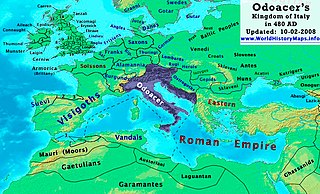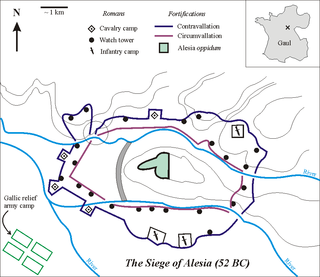The Julian calendar is a solar calendar of 365 days in every year with an additional leap day every fourth year. The Julian calendar is still used as a religious calendar in parts of the Eastern Orthodox Church and in parts of Oriental Orthodoxy as well as by the Amazigh people.
AD 68 (LXVIII) was a leap year starting on Friday of the Julian calendar. At the time, it was known as the Year of the Consulship of Silius Italicus and Trachalus, or the start of the Year of the Four Emperors. The denomination AD 68 for this year has been used since the early medieval period, when the Anno Domini calendar era became the prevalent method in Europe for naming years. These are now used throughout the world.
AD 43 (XLIII) was a common year starting on Tuesday of the Julian calendar. At the time, it was known as the Year of the Consulship of Caesar and Vitellius. The denomination AD 43 for this year has been used since the early medieval period, when the Anno Domini calendar era became the prevalent method in Europe for naming years.

The 80s was a decade that ran from January 1, AD 80, to December 31, AD 89.
AD 7 was a common year starting on Saturday of the Julian calendar. In the Roman Empire, it was known as the Year of the Consulship of Metellus and Nerva. The denomination "AD 7" for this year has been used since the early medieval period, when the Anno Domini calendar era became the prevalent method in Europe for naming years.
AD 21 (XXI) was a common year starting on Wednesday of the Julian calendar. At the time, it was known as the Year of the Consulship of Tiberius and Drusus. The denomination AD 21 for this year has been used since the early medieval period, when the Anno Domini calendar era became the prevalent method in Europe for naming years.

Year 480 (CDLXXX) was a leap year starting on Tuesday of the Julian calendar. At the time, it was known as the Year of the Consulship of Basilius without colleague. The denomination 480 for this year has been used since the early medieval period, when the Anno Domini calendar era became the prevalent method in Europe for naming years.
AD 38 (XXXVIII) was a common year starting on Wednesday of the Julian calendar. At the time, it was known as the Year of the Consulship of Iulianus and Asprenas. The denomination AD 38 for this year has been used since the early medieval period, when the Anno Domini calendar era became the prevalent method in Europe for naming years.
AD 40 (XL) was a leap year starting on Friday of the Julian calendar. At the time, it was known as the Year of the Consulship of Augustus without colleague. The denomination AD 40 for this year has been used since the Early Middle Ages, when the Anno Domini calendar era became the prevalent method in Europe for naming years.
AD 45 (XLV) was a common year starting on Friday of the Julian calendar. At the time, it was known as the Year of the Consulship of Vinicius and Corvinus. The denomination AD 45 for this year has been used since the early medieval period, when the Anno Domini calendar era became the prevalent method in Europe for naming years.

AD 50 (L) was a common year starting on Thursday of the Julian calendar. At the time it was known in Europe as the Year of the Consulship of Vetus and Nerullinus. The denomination AD 50 for this year has been used since the Early Middle Ages, when the Anno Domini calendar era became the prevalent method in Europe for naming years.
AD 64 (LXIV) was a leap year starting on Sunday of the Julian calendar, the 64th Year of the Anno Domini designation, the 64th year of the 1st millennium, the 64th year of the 1st century, and the 4th year of the 7th decade. At the time, it was known as the Year of the Consulship of Bassus and Crassus. The denomination AD 64 for this year has been used since the early medieval period, when the Anno Domini calendar era became the prevalent method in Europe for naming years.
AD 65 (LXV) was a common year starting on Tuesday of the Julian calendar. At the time, it was known as the Year of the Consulship of Nerva and Vestinus. The denomination AD 65 for this year has been used since the early medieval period, when the Anno Domini calendar era became the prevalent method in Europe for naming years.
AD 78 (LXXVIII) was a common year starting on Thursday of the Julian calendar. At the time, it was known as the Year of the Consulship of Novius and Commodus. The denomination AD 78 for this year has been used since the early medieval period, when the Anno Domini calendar era became the prevalent method in Europe for naming years.
AD 90 (XC) was a common year starting on Friday of the Julian calendar. At the time, it was known as the Year of the Consulship of Domitian and Nerva. The denomination AD 90 for this year has been used since the early medieval period, when the Anno Domini calendar era became the prevalent method in Europe for naming years.

Year 280 (CCLXXX) was a leap year starting on Thursday of the Julian calendar. At the time, it was known as the Year of the Consulship of Messalla and Gratus. The denomination 280 for this year has been used since the early medieval period, when the Anno Domini calendar era became the prevalent method in Europe for naming years.

Year 50 BC was a year of the pre-Julian Roman calendar. At the time, it was known as the Year of the Consulship of Paullus and Marcellus. The denomination 50 BC for this year has been used since the early medieval period, when the Anno Domini calendar era became the prevalent method in Europe for naming years.

Year 52 BC was a year of the pre-Julian Roman calendar. At the time, it was known as the Year of the Consulship of Pompeius and Scipio. The denomination 52 BC for this year has been used since the early medieval period, when the Anno Domini calendar era became the prevalent method in Europe for naming years.
Year 54 BC was a year of the pre-Julian Roman calendar. At the time, it was known as the Year of the Consulship of Appius and Ahenobarbus. The denomination 54 BC for this year has been used since the early medieval period, when the Anno Domini calendar era became the prevalent method in Europe for naming years.
Year 120 BC was a year of the pre-Julian Roman calendar. At the time it was known as the Year of the Consulship of Manilius and Carbo and the Third Year of Yuanshou. The denomination 120 BC for this year has been used since the early medieval period, when the Anno Domini calendar era became the prevalent method in Europe for naming years.





